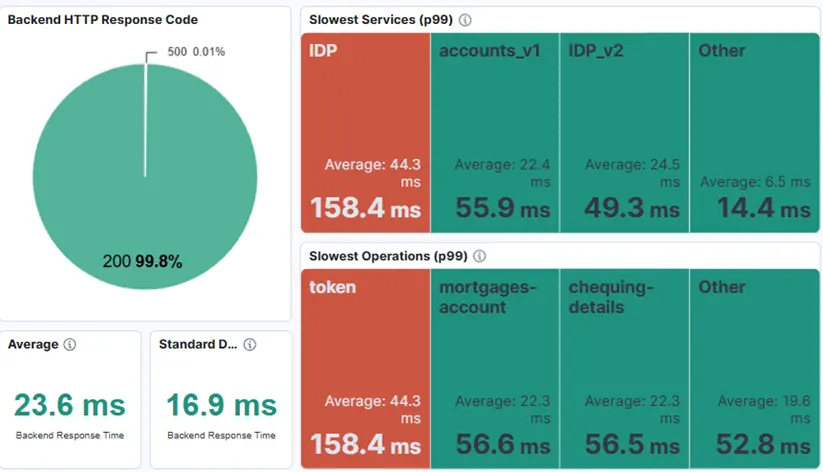Are Your APIs Performing? The Importance of Measuring API Service Levels
Published: March 20, 2025

Imagine walking into a busy restaurant. You place your order with the waiter, expecting it to arrive quickly, correctly, and just as promised on the menu. If the service is slow, orders are mixed up, or the kitchen is constantly out of ingredients, you won’t be coming back. APIs work the same way. They are the “waiters” of the digital world, taking in requests from customers (users, partners, or other services), fetching the right data, and delivering it quickly and accurately.
Ensuring APIs meet these expectations falls under SLA (Service Level Agreement) compliance, a critical aspect of API management. Businesses need to ensure their APIs are not just functional but also fast, available, and reliable. This is where API gateways and robust monitoring strategies come into play, helping organizations track API performance and respond to issues before they impact users.
Why SLA Compliance Matters
For industries like healthcare and government, API SLAs aren’t just about keeping customers happy; they’re about regulatory compliance, security, and service reliability. Healthcare APIs must meet strict uptime and performance standards to ensure doctors and patients have uninterrupted access to electronic health records. Government APIs, such as those handling tax filings or immigration services, must be resilient to prevent service disruptions that could impact millions.
SLA compliance starts with understanding three key concepts:
- SLI (Service Level Indicator): The actual measured performance of an API (e.g., response time, uptime, error rate).
- SLO (Service Level Objective): The target or goal for performance based on business needs (e.g., 99.9% uptime).
- SLA (Service Level Agreement): The formal contract or commitment to meeting specific service levels, often with penalties for violations.
Even if you don’t offer an SLA to your customers, knowing how an API is performing and when there are issues, its SLIs, is key to delivering reliable services and planning for the future.
The Role of API Gateways and Monitoring Tools
API gateways act as traffic managers, ensuring that APIs are secure, properly routed, and performing as expected. They also enforce rate limits, authentication policies, and other governance controls that help maintain SLA compliance. In my experience, monitoring is just as important. Tools like Splunk and Elastic provide real-time analytics, helping companies track SLIs and compare them against SLOs to ensure they are meeting SLAs.
Example of SLA Metrics Dashboard

For example, in healthcare, a hospital using an API to pull patient records from different systems needs to know when response times are slowing down. Monitoring logs can reveal bottlenecks, allowing teams to proactively address issues before they affect doctors and patients. Similarly, a government agency managing online services must track API performance to ensure services are available to citizens without disruption. Businesses that run mobile applications, sales sites, or web portals or services need to know that APIs are performative. It is critical to the response time and functionality of those tools, and to keeping your customers happy.
How Solsys Helps Businesses Stay SLA-Compliant
At Solsys, we specialize in helping businesses navigate complex API challenges which can help to meet SLA commitments. Our expertise also spans industries where compliance isn’t optional. These include healthcare, finance, and government. By helping to implement API management strategies, we help companies ensure their APIs are performing as expected, reducing downtime, and mitigating risks before they become critical failures.
One of the key strategies we employ is log analytics. By collecting and analyzing API logs in real-time, we provide insights into performance trends, detect anomalies, and set up automated alerts when SLIs fall below acceptable thresholds. This allows businesses to take corrective action before an SLA breach impacts customers or results in regulatory penalties. We know what to log, how to log it without performance impacts, and can provide reporting, alerting, and analytics over those records without significant expense.
Why This Matters to You
Just like in a restaurant where service quality defines the customer experience, APIs must consistently deliver on their promises. Managing SLAs is about more than just tracking numbers, it’s about ensuring seamless digital interactions for customers, partners, and users. With the right API gateway, monitoring tools, and compliance strategies in place, businesses can stay ahead of performance issues and build trust with their users.
Solsys has the expertise to help organizations master API performance management and SLA compliance. Whether you’re in healthcare, government, or any other industry that relies on APIs, we can help you ensure your services run smoothly and meet the highest standards of reliability and efficiency.



